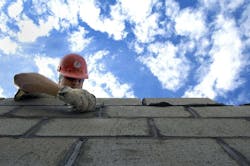Following the first reversal into negative territory in ten months in April, the Architecture Billings Index has bounced back in May. As a leading economic indicator of construction activity, the ABI reflects the approximate nine to twelve month lag time between architecture billings and construction spending.
The American Institute of Architects (AIA) reported the May ABI score was 52.9, up dramatically from a mark of 48.6 in April. This score reflects an increase in demand for design services (any score above 50 indicates an increase in billings). The new projects inquiry index was 59.1, up slightly from the reading of 58.5 the previous month.
“This rebound is a good sign for the design and construction industry and hopefully means that April’s negative dip was a blip rather than a sign of challenging times to come,” said AIA Chief Economist, Kermit Baker, PhD, Hon. AIA. “But there is a resounding sense of uncertainty in the marketplace – from clients to investors and an overall lack of confidence in the general economy – that is continuing to act as a governor on the business development engine for architecture firms.”
Key May ABI highlights:
- Regional averages: Northeast (53.7), West (52.1), South (50.9), Midwest (47.5)
- Sector index breakdown: multi-family residential (52.8), institutional (52.2), mixed practice (51.0), commercial / industrial (47.5)
- Project inquiries index: 59.1
The regional and sector categories are calculated as a 3-month moving average, whereas the index and inquiries are monthly numbers.
About the AIA Architecture Billings Index
The Architecture Billings Index (ABI), produced by the AIA Economics & Market Research Group, is a leading economic indicator that provides an approximately nine to twelve month glimpse into the future of nonresidential construction spending activity. The diffusion indexes contained in the full report are derived from a monthly “Work-on-the-Boards” survey that is sent to a panel of AIA member-owned firms. Participants are asked whether their billings increased, decreased, or stayed the same in the month that just ended as compared to the prior month, and the results are then compiled into the ABI. These monthly results are also seasonally adjusted to allow for comparison to prior months. The monthly ABI index scores are centered around 50, with scores above 50 indicating an aggregate increase in billings, and scores below 50 indicating a decline. The regional and sector data are formulated using a three-month moving average. More information on the ABI and the analysis of its relationship to construction activity can be found in the White Paper Architecture Billings as a Leading Indicator of Construction: Analysis of the Relationship Between a Billings Index and Construction Spending on the AIA web site.
About The American Institute of Architects
Founded in 1857, members of the American Institute of Architects consistently work to create more valuable, healthy, secure, and sustainable buildings, neighborhoods, and communities. Through nearly 300 state and local chapters, the AIA advocates for public policies that promote economic vitality and public well being. Members adhere to a code of ethics and conduct to ensure the highest professional standards. The AIA provides members with tools and resources to assist them in their careers and business as well as engaging civic and government leaders, and the public to find solutions to pressing issues facing our communities, institutions, nation and world. Visit www.aia.org.
